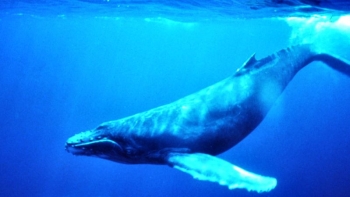
Publisher:
Bonnie King
CONTACT:
Newsroom@Salem-news.com
Advertising:
Adsales@Salem-news.com

~Truth~
~Justice~
~Peace~
TJP
May-16-2007 09:42

 TweetFollow @OregonNews
TweetFollow @OregonNews
Whales Trapped in Northern California River Near Sacramento
Salem-News.comUSCG reports indicate that the whales are free swimming and headed in a northerly direction.
 Photo courtesy: Wikipedia.com |
(RIO VISTA, Calif.) - The U.S. Coast Guard has received reports of whale sightings in the Sacramento River in vicinity of Rio Vista.
The reports indicate that the whales are free swimming and headed in a northerly direction.
However, the Sacramento Bee Newspaper is reporting a pair of humpback whales appears to be trapped in the Sacramento River because of fishing gear or rope in the California waterway.
Television footage of the whales - believed to be a mother and her calf - show the two playing in the canal about two miles south of the Port of Sacramento.
They were headed upriver toward the turning basin used for deep-water ships, a journey of more than 50 miles from the point where the Sacramento and San Joaquin rivers merge at Suisun Bay.
Sector San Francisco issued a Marine Safety Information Bulletin (MSIB) over VHF-FM channel 16 to alert mariners in the area of the whales' presence.
An updated MSIB will be broadcast upon receipt of updated position reports.
A 100-yard moving Safety Zone, which forbids vessels from coming within 100 yards of the whales, has also been established.
Aircraft should also remain above 1000 feet when in the vicinity of the whales.
*The Humpback Whale is a baleen whale.
One of the larger rorqual species, adults range in length from 12–16 metres (40–50 ft) and weigh approximately 36,000 kilograms (79,000 lb).
The Humpback has a distinctive body shape, with unusually long pectoral fins and a knobbly head. It is an acrobatic animal, often breaching and slapping the water.
Males produce a complex whale song, which lasts for 10 to 20 minutes and is repeated for hours at a time.
The purpose of the song is not yet clear, although it appears to have a role in mating.
Found in oceans and seas around the world, Humpback Whales typically migrate up to 25,000 kilometres each year.
Humpbacks feed only in summer, in polar waters, and migrate to tropical or sub-tropical waters to breed and give birth in the winter.
During the winter, Humpbacks fast and live off their fat reserves. The species' diet consists mostly of krill and small fish. Humpbacks have a diverse repertoire of feeding methods, including the spectacular bubble net fishing technique.
Like other large whales, the Humpback was a target for the whaling industry, and its population fell by an estimated 90% before a whaling moratorium was introduced in 1966.
* Information from Wikipedia, the free encyclopedia.
Articles for May 15, 2007 | Articles for May 16, 2007 | Articles for May 17, 2007

Salem-News.com:
Quick Links
DINING
Willamette UniversityGoudy Commons Cafe
Dine on the Queen
Willamette Queen Sternwheeler
MUST SEE SALEM
Oregon Capitol ToursCapitol History Gateway
Willamette River Ride
Willamette Queen Sternwheeler
Historic Home Tours:
Deepwood Museum
The Bush House
Gaiety Hollow Garden
AUCTIONS - APPRAISALS
Auction Masters & AppraisalsCONSTRUCTION SERVICES
Roofing and ContractingSheridan, Ore.
ONLINE SHOPPING
Special Occasion DressesAdvertise with Salem-News
Contact:AdSales@Salem-News.com

googlec507860f6901db00.html

Terms of Service | Privacy Policy
All comments and messages are approved by people and self promotional links or unacceptable comments are denied.
James John May 25, 2007 8:09 am (Pacific time)
So I had a thought earlier today. I'm educated but have no expertise in this matter... But. Whales and dolphins are part of the same family (Cetaceans I believe) and have been known to look for one another in the wild. We have ocean trained dolphins, oddly our navy uses them to help locate submerged mines. So, is it possible to use trained dolphins in the Sac River to help guide the whales out of the bay. Prob a longshot, but nothing else seem to be working.
JW Dewdney May 24, 2007 2:15 am (Pacific time)
They're not LOST. They're seeking respite from US Navy Sonar. I really don't know why the media isn't connecting these things. It makes me quite angry.
[Return to Top]©2025 Salem-News.com. All opinions expressed in this article are those of the author and do not necessarily reflect those of Salem-News.com.